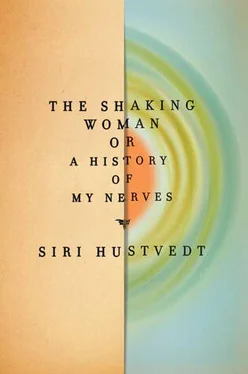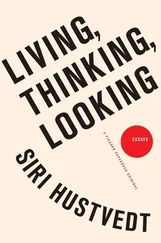101. Merleau-Ponty, “Child’s Relation to Others,” 151.
102. Margarite Sechehaye, Autobiography of a Schizophrenic Girl: The True Story of Renee, trans. Grace Rubin-Rabson (New York: Penguin, 1994), 52–53.
103. Quoted in J. Laplanche and J. B. Pontalis, The Language of Psychoanalysis, trans. Donald Nicholson-Smith (New York: Norton, 1973), 199.
104. Leo Tolstoy, “The Death of Iván Ilých,” in Great Short Works of Leo Tolstoy, trans. Louise Maude and Aylmer Maude (New York: Harper & Row, 1967), 280.
105. Ibid., 282.
106. Albertus Magnus, “Commentary on Aristotle,” “On Memory and Recollection,” The Medieval Craft of Memory: An Anthology of Texts and Pictures, ed. Mary Carruthers and Jan M. Ziolkowski (Philadelphia: University of Pennsylvania Press, 2002), 153–188.
107. A. R. Luria. The Mind of a Mnemonist: A Little Book About a Vast Memory, trans. Lynn Solotaroff (Cambridge, MA: Harvard University Press, 1987),32.
108. Quoted in Patricia Lynne Duffy, Blue Cats and Chartreuse Kittens: How Synesthetes Color Their World (New York: Henry Holt, 2001), 22.
109. Arthur Rimbaud, Complete Works, trans. Paul Schmidt (New York: Harper & Row, 1967), 123.
110. Luria, Mind of a Mnemonist, 31.
111. Jorge Luis Borges, “Funes the Memorious,” Labyrinths: Selected Stories and Other Writings (New York: New Directions, 1964), 65–67.
112. Luria, Mind of a Mnemonist, 154.
113. Ibid., 155.
114. Freud used Nachträglichkeit, deferred action, throughout his writing, from 1896, in a letter to his friend Fliess, onward. For a clear account of this complex term and why deferred action might not be the best translation, see Laplanche and Pontalis, Language of Psychoanalysis, 111–14.
115. Joseph LeDoux, Synaptic Self: How Our Brains Become Who We Are (New York: Penguin, 2002), 124.
116. Demis Hassabis, Dharshan Kumaran, Seralynne D. Vann, and Eleanor Maguire, “Patients with Hippocampal Amnesia Cannot Imagine New Experiences,” Proceedings of the National Academy of Sciences 104 (2007): 1726–31.
117. LeDoux, Synaptic Self, 217.
118. Francis Crick, The Astonishing Hypothesis: The Scientific Search for the Soul (New York: Simon & Schuster, 1995), 3.
119. LeDoux, Synaptic Self, 94.
120. S. J. Blakemore, D. Bristow, G. Bird, C. Frith, and J. Ward, “Somatosensory Activations Following the Observation of Touch and a Case of Vision Touch Synesthesia,” Brain 128 (2005): 1571–83; and Michael J. Banissy and Jamie Ward, “Mirror Touch Synesthesia Is Linked to Empathy,” Nature Neuro-science 10 (2007): 815–16.
121. Luria, Mind of a Mnemonist, 82.
122. Duffy, Blue Cats, 33.
123. See Peter Brugger, “Reflective Mirrors: Perspective-Taking in Autoscopic Phenomenon,” Cognitive Neuropsychiatry 7 (2002): 188.
124. K. Hitomi, “ ‘Transitional Subject’ in Two Cases of Psychotherapy of Schizophrenia,” Schweizer Archiv für Neurologie und Psychiatrie 153, no. 1 (2002), 39–41.
125. Ibid., 40.
126. Winnicott, Playing and Reality, 2.
127. Freud, Mourning and Melancholia, Standard Edition, vol. 14, trans. James Strachey (London: Hogarth Press, 1957).
128. After reading the manuscript of this book, a friend of mine who is also a psychoanalyst pointed out that to have a lump in one’s throat means sadness.
129. Theodore Roethke, “Silence,” Collected Poems (New York: Doubleday, 1966).
130. Sigmund Freud, The Interpretation of Dreams, Standard Edition, vol. 4, trans. James Strachey (London: Hogarth Press, 1953, 1971), 279.
131. Cited in Mark Solms, “Dreaming and REM Sleep Are Controlled by Different Brain Mechanisms,” Sleep and Dreaming: Scientific Advances and Reconsiderations (Cambridge: Cambridge University Press, 2003), 52.
132. J. Allan Hobson, Dreaming: An Introduction to the Science of Sleep (Oxford: Oxford University Press, 2002), 155–56.
133. Antti Revonsuo, “The Reinterpretation of Dreams: An Evolutionary Hypothesis of the Function of Dreaming,” Sleep and Dreaming, 89.
134. Ibid., 94.
135. Solms, Sleep and Dreaming, 56.
136. Dream Debate: Hobson vs. Solms — Should Freud’s Dream Theory Be Abandoned? DVD, NetiNeti Media, 2006. For another view that disagrees with both Hobson and Solms, see G. W. Domhoff, “Refocusing the Neurocognitive Approach to Dreams: A Critique of the Hobson Versus Solms Debate,” Dreaming 15 (2005): 3–20.
137. William James, Pragmatism . In Writings 1902–1910 (New York: Library of America, 1987), 491.
138. For a brief discussion of color as a prereflective phenomenon, see Kym Maclaren, “Embodied Perceptions of Others as a Condition of Selfhood,” Journal of Consciousness Studies 15, no. 8 (2008): 75.
139. The Mary story has been told and retold in many different papers, books, and lectures. For an argument against the Mary story as a proof of qualia, see Daniel Dennett, Consciousness Explained (Boston: Little, Brown, 1991), 398–401.
140. Ned Block’s interview is in Susan Blakemore, Conversations on Consciousness (Oxford: Oxford University Press, 2005), 24–35.
141. Peter Carruthers’s paper, published in the Journal of Philosophy, was sent to me by the “sympathetic” philosopher Ned Block after I had heard the lecture on theories of consciousness he gave in February 2009 at the New York Psychoanalytic Institute in New York City. “Brute Experience,” Journal of Philosophy 86 (1989): 258–69.
142. Ludwig Wittgenstein, Tractatus Logico-Philosophicus, trans. D. F. Pears and B. F. McGuinness (London: Routledge & Kegan Paul, 1963), 151.
143. Simone de Beauvoir, Philosophical Writings, ed. Margaret A. Simons (Urbana: University of Illinois Press, 2004), 159.
144. For a useful introduction to Patricia Churchland’s view of the mind, as well as those of several other prominent neuroscientists and philosophers, see Blakemore, Conversations on Consciousness .
145. Francisco J. Varela, Evan Thompson, and Eleanor Rosch, The Embodied Mind: Cognitive Science and the Human Experience (Cambridge, MA: MIT Press, 1993).
146. The physicist Erwin Schrodinger offers a view of consciousness that draws insights from the Upanishads and Schopenhauer in a remarkable, if neglected little book published after his death. Erwin Schrodinger, My View of the World, trans. Cecily Hastings (Woodbridge, Conn: Ox Bow Press, 1983). On page 88 he gives us the colors he associates with vowels, writing about his synesthesia as a common phenomenon: “For me they are a — pale mid-brown, e — white, i — intense, brilliant blue, o — black, u — chocolate brown.”
147. Jan-Markus Schwindt, “Mind as Hardware and Matter as Software,” Journal of Consciousness Studies 15, no. 4 (2008): 22–23.
148. George Berkeley, The Principles of Human Knowledge, pt. 1, Berkeley’s Philosophical Writings, ed. David M. Armstrong (New York: Collier, 1965), 63.
149. Schwindt, “Mind as Hardware,” 25.
150. Imants Baruss, “Beliefs About Consciousness and Reality,” Journal of Consciousness Studies 15, no. 10–11 (2008): 287.
151. D. Berman and W. Lyons, “J. B. Watson’s Rejection of Mental Images,” Journal of Consciousness Studies 14, no. 11 (2007): 24.
152. Steven C. Schachter, Gregory Holmes, and Dorthée G. A. Kasteleijn-Nolst Trenité, Behavioral Aspects of Epilepsy: Principles and Practice (New York: Demos, 2008), 471.
Читать дальше












